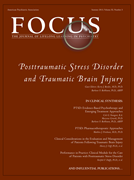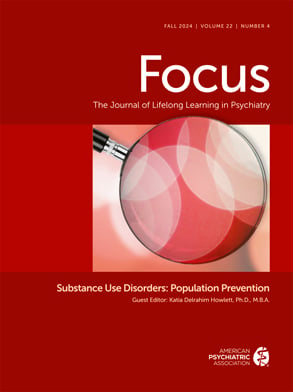“My patient is a former soldier. He reports he had “TBI” and has PTSD and now is telling me about his suicidal thoughts. What are the risk predictors and the approach to this patient?”
Reply from Robert J. Ursano, M.D.
Since 2004 the rates of suicide in the U.S. Army have doubled. Prior to the war in Iraq and Afghanistan the rates of suicide in soldiers was about half that of age- and gender-matched comparisons; now it is equal to that of this group (
1,
2). Yes, that is correct: being in the Army was previously protective from suicide—perhaps for many reasons. All were employed, had health insurance, and nearly all were high school graduates. Although these factors have stayed the same, the rates of suicide have doubled. However, as we all know, suicide is not only a problem for the military. In the United States there are nearly a million suicide attempts every year. That is more than the number of heart attacks. The rate of suicide now exceeds that of motor vehicle accidents, and suicide has the highest annual incidence of all intentional or unintentional injuries (
3).
Traumatic brain injury (TBI) has been called the “signature” injury of the war (
4). But recent studies now document how common it also is in the United States and internationally. Recent studies show that nearly half of soldiers coming into the Army report a concussion prior to ever entering the army. And studies of sports injuries in high school now document the frequency of TBI and our need to better address it as a health risk of adolescence, males, and females. TBI is often diagnosed by history, and estimates of the frequency are based on surveys that ask about being dazed or “having your bell rung” and if one was unconscious and the duration of the unconsciousness. Mild TBI can include being dazed without loss of consciousness.
Posttraumatic stress disorder (PTSD) is well known following trauma of all kinds and in particular war trauma. Estimates have shown 10%−15% of troops exposed to combat return from deployment with PTSD. PTSD diagnosis has changed somewhat in DSM-5 (
5). The diagnosis now separates numbing and negative symptoms from avoidance, more clearly delineates the exposure criteria (A1), and eliminates the criteria of experiencing fear, etc. (A2). The elimination of A2 is particularly important, since often trained soldiers will tell you they never experienced an A2 criterion yet meet all the criteria for PTSD. PTSD following combat can include a moral dimension that interweaves guilt or moral concern about killing in the response to the events. This must be addressed in any psychotherapeutic treatment. Depression and substance abuse are common comorbidities that require assessment and treatment.
The patient with TBI, PTSD, and suicidality is a complex assessment as well as treatment. Determining the specific nature and severity of TBI is important and may require a neurological examination. If the patient was dazed, he or she may never have lost consciousness or perhaps even been evaluated medically. In the later part of the war, a systematic “stand down” was initiated for those with TBI (better thought of as concussion) to provide rest after the event. But that may not have occurred. Neurological exam and perhaps consultation are indicated. Psychological testing may be indicated if there is concern about persistent memory loss, concentration disturbance, or impulsivity.
Suicidality requires careful assessment. In particular the availability of firearms, common among soldiers, should be inquired about. Suicidal thoughts, homicidal thoughts, suicidal plans and past history of attempts are all important risk factors. Depression is the most common predictor of suicidal thoughts and requires careful assessment and treatment. But anxiety disorders are a risk indicator for suicide attempts among those with suicidal ideation (
6). Those with PTSD have been found to be at 4–6 times increased risk for suicidality even after controlling for the presence of depression. Suicide is a complex behavior that can accompany loss of close relationships and has been thought to be associated with increased detachment or insensitivity to pain and hopelessness and loss of “a way forward.” Substance abuse can increase impulsivity and therefore risk. Binge drinking has been found to be common in soldiers and young adults and is itself an indicator of impulsive behaviors.
PTSD treatment is both pharmacologic (SSRIs) and psychotherapeutic (
7). Prolonged exposure psychotherapy and cognitive processing psychotherapy (a cognitive behavioral therapy) are both effective. Although studies show EMDR to be effective, it is its CBT elements that are the effective component. War-related PTSD may not be as responsive to SSRIs. Therefore several trials may be needed. Psychotherapeutic treatments are very effective and can address the complexity of war-related experiences as well as the prominent arousal symptoms. It is important to also focus treatment to symptoms that may not remit, such as sleep problems and to the function and disability which may accompany this complex diagnostic group. Treatment is always a process of treating an illness, i.e., how a disease appears in a particular patient, and targeting all of the elements of the illness: the disorder, symptoms, function, disability, and trajectory over time (
8).
Because your patient has reached treatment, he or she is better off than many with PTSD. Estimates show that in the United States the average length of time is nearly 12 years from trauma to diagnosis and even then only about two-thirds ever reach treatment. Reminding your primary care colleagues about the importance of screening for trauma exposure of all types (
9), in particular war, is important and can easily be included in depression screening, an already well-established and growing part of primary care.

